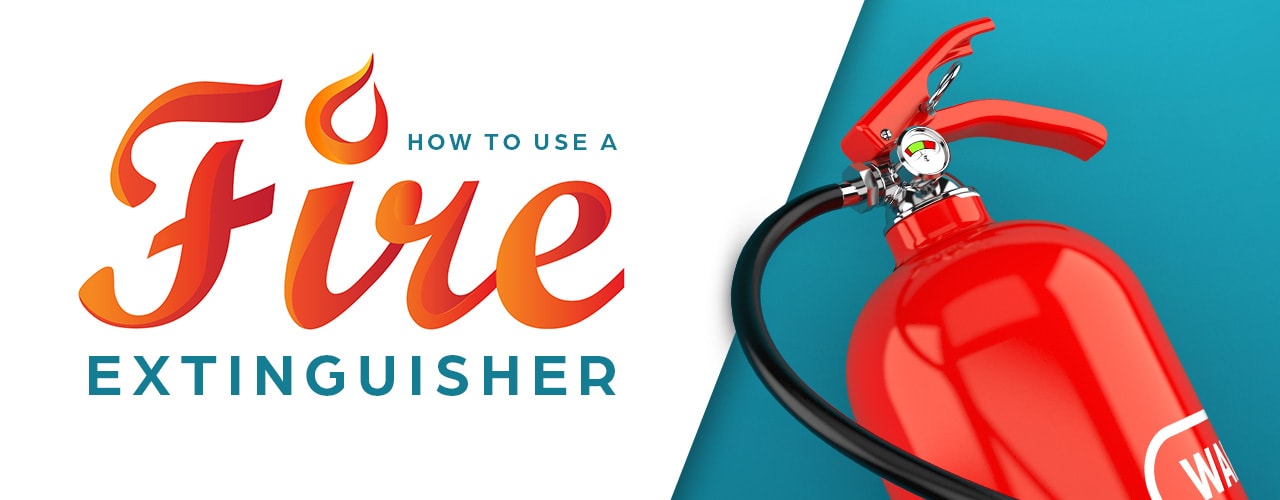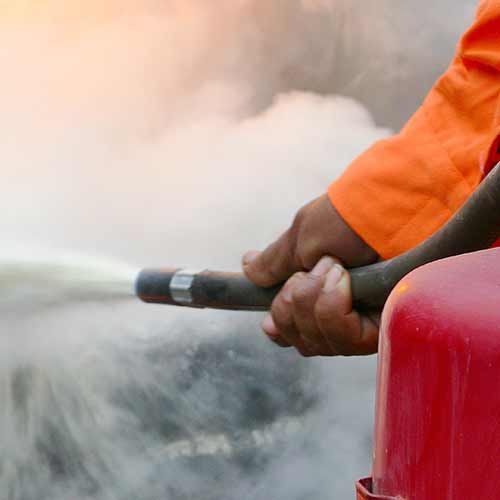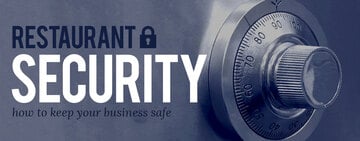
How to Use a Fire Extinguisher
Last updated on 12/20/2022A fire extinguisher is an essential fire safety tool to keep in any workplace. For the safety of your employees and guests, it is required by law for any commercial business to keep a fire extinguisher readily available. Many states even require employees to be trained to use one. Below, we’ll investigate the different parts of a fire extinguisher, how to properly use one, and how to properly clean up fire extinguisher residue.
Shop All Fire ExtinguishersFire Extinguisher Video
If you've never used a fire extinguisher before, watch the video below for a step-by-step guide on how to use one properly:
Parts of a Fire Extinguisher

Although there are different types of fire extinguishers, most share the same general design. To fully understand how to use a fire extinguisher, it’s important to familiarize yourself with the different parts, what they do, and how they work with one another. Below, we’ll introduce the eight different parts of a fire extinguisher and what they are used for:
- Safety pin: The safety pin is a key part of the fire extinguisher. It is inserted into the valve to prevent accidental discharge and must be removed before attempting to use your fire extinguisher.
- Discharge lever: The discharge lever is what allows you to operate the fire extinguisher. After removing the safety pin, this lever can be pushed to use the fire extinguisher.
- Carrying handle: As its name suggests, the carrying handle allows you to carry and transport the fire extinguisher.
- Pressure gauge: A pressure gauge displays the pressure inside a fire extinguisher’s canister. If the pressure is too low, your extinguisher will not operate correctly.
- Pickup tube: Sometimes referred to as a discharge hose, a pickup tube is what allows an extinguishing agent to travel from the tank to the nozzle.
- Gas canister: The gas canister stores expellant, which is released when one pulls the nozzle. It propels the extinguishing agent out of the fire extinguisher.
- Extinguishing agent: An extinguishing agent is a chemical substance stored within the fire extinguisher’s tank. It is expelled from the nozzle to quickly put out fires.
- Discharge nozzle: A discharge nozzle is located on the end of a fire extinguisher’s hose and is what the extinguishing agent is dispersed through.
Fire Extinguisher Instructions
When using a fire extinguisher, there is a simple technique to help you remember the proper instructions to put out a fire. The PASS technique is a four-step method that walks the user through exactly how to properly use a fire extinguisher. We'll break down each step of the fire extinguisher PASS system and how it can help you correctly use a fire extinguisher:
PASS Technique
- Pull: To use your fire extinguisher, pull the safety pin and release the locking mechanism. Be sure to point the nozzle away from yourself and others.
- Aim: Once you've pulled the pin, aim your fire extinguisher at the base of the fire. This ensures that you are extinguishing the fire at the source.
- Squeeze: To begin putting out the fire, squeeze the lever of your fire extinguisher slowly and evenly to ensure the expellant is dispersed correctly.
- Sweep: While aiming at the base of the fire, sweep the nozzle from side to side to ensure you extinguish the fire evenly.
How to Clean Fire Extinguisher Residue

Hopefully, you never encounter a situation in which you need to use a fire extinguisher in your workplace. In the unfortunate event that you do, it’s important to know not just how to use a fire extinguisher, but how to clean up after using one. Before you begin cleaning fire extinguisher residue, consider the following factors:
- Residue type: There are three main types of fire extinguisher residue: dry chemical residue, wet chemical residue, and dry powder residue. Each requires specific clean-up methods. Check the label of your fire extinguisher to see what expellant type it uses to prepare appropriately.
- Safety concerns: Although fire extinguisher residues are typically considered to be non-toxic, exposure to residue can sometimes result in irritated eyes or skin. Remember to have safety equipment on hand and take the appropriate steps to limit contact with residue after it’s been used.
How to Clean Dry Chemical Fire Extinguisher Residue
Dry chemical fire extinguishers, such as ABC fire extinguishers, put out fires by covering them with a layer of dust that separates the fire from oxygen in the air. Their powder is corrosive, meaning that it will damage metal surfaces and even electronics if left in place. To protect yourself from these chemicals, consider wearing appropriate PPE like dust masks, gloves, and eye protection. To clean up after using a dry chemical fire extinguisher, follow the steps below:
- Remove excess residue: Using a vacuum or broom, remove as much of the excess residue as you can.
- Mix cleaning solution: The solution you use depends on the type of residue left over. For silicone-based residue, use a solution of 50% isopropyl alcohol and 50% warm water. For sodium bicarbonate or potassium bicarbonate residue, use a solution of 98% hot water and 2% vinegar. For monoammonium based residue, use a solution of hot water and baking soda.
- Spray: Using your cleaning solution, spray the area to remove any leftover residue.
- Let the solution settle: No matter what solution you have to use, be sure to let it settle for five minutes. Giving the solution time to settle ensures that the area is properly cleaned.
- Wash and rinse: Using soap and water, clean the area once more to ensure any remnants are removed.
How to Clean Wet Chemical Fire Extinguisher Residue

Wet chemical fire extinguishers are commonly used to extinguish fires that occur while cooking. In particular, they are effective at combatting grease fires caused by oils and fats. For safety reasons, be sure to protect your hands, eyes, and mouth while cleaning wet chemical fire extinguisher residue. To effectively clean up after using this type of extinguisher, adhere to the steps below:
- Disable fuel: Turn off all fuel sources connected to cooking equipment that might be in the vicinity.
- Scrub: Using a sponge or cloth, scrub the area with hot water and soap.
- Rinse: After scrubbing, rinse the affected area thoroughly.
How to Clean Up Dry Powder Fire Extinguisher Residue
A dry powder fire extinguisher is typically used to extinguish fires stemming from combustible metals, often found in warehouses or factories. As you clean, remember to protect your hands and eyes as you clean up residue from this type of extinguisher. To best clean up after using a dry powder extinguisher, follow these steps:
- Remove powder: Using a vacuum cleaner or brush, remove as much excess powder as you can.
- Dispose of powder: Place the powder you’ve removed in a plastic bag, sealing it afterward. Dispose of the bag in the trash.
- Wash: Using a damp cloth, clean up any remaining residue on the affected surface.
Knowing how to use a fire extinguisher is an essential skill for anyone working in the foodservice or hospitality industry. By familiarizing yourself with the different parts of a fire extinguisher, the PASS method, and the varying ways that you can clean up fire extinguisher residue, you'll be able to prepare for emergencies that might occur in the workplace. Check out our fire extinguisher reviews to find the right one for your business.






